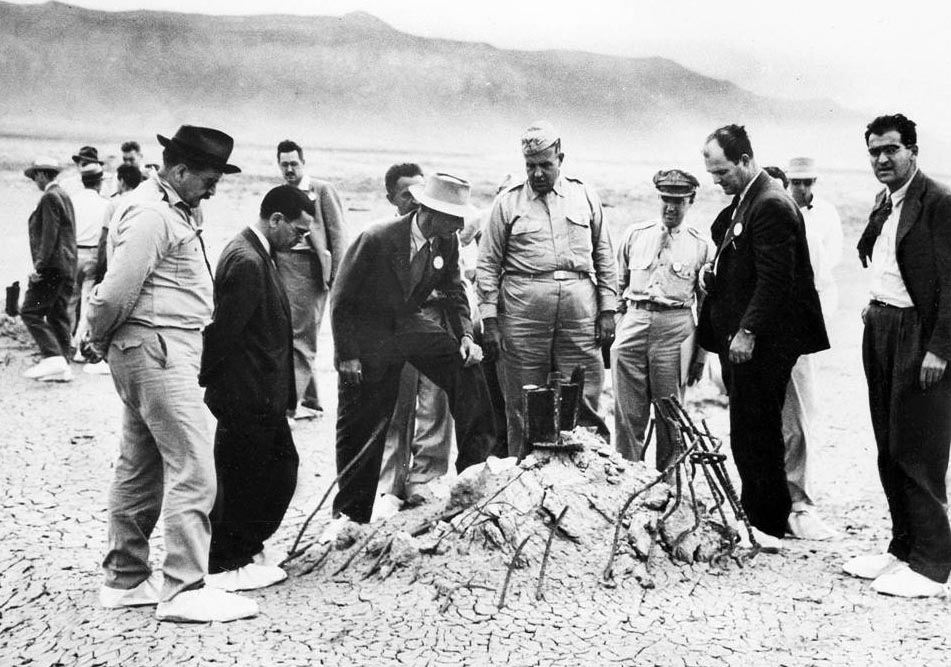“Therefore that he may raise, the Lord throws down.”
–Hymn to God, My God, in My Sickness, John Donne
Christopher Nolan’s biopic film Oppenheimer (2023) retells possibly the most important event in twentieth century world history. The saga was destined to belong to Nolan, eventually—it was simply a matter of “time.” For such a time as this his filmmaking talent reaches a pinnacle that began with Memento (2000), a unique way of storytelling in reverse. He refers to this as a hairpin plot. Nolan’s work should come with a hazard sign indicating sharp turns ahead, but they are often Lucretian “swerves”, surprising plot twists that defy explanation (often leaving questions unanswered). Epicurean physics (developed before Christ) theorized that atomic reversals could occur at no fixed time or space (spontaneous and unpredictable). Expressed in a poem, the first atomic theory and the interplay of human free will were twin topics in Lucretius’ On the Nature of Things and On the Nature of the Universe. Nolan too uses the poetic—language arranged to evoke emotions through meaning, sound, and rhythm—to hint at the paradoxical possibility of light breaking in upon the dark souls of men at war.
Redemption only has a slight chance in the film, as the ending portrays an overarching trajectory of doom. Covering over 80% of the film, Nolan uses sound to helps us “feel” the horror, while reminding us that we are part of a dirge—a lament for the dead. Note that he doesn’t allow us to “see” the horror. Reba Wissner, assistant professor of musicology at Columbus State University analyzes Nolan’s choice of the violin to be the foundational instrument in the score. She highlights its “great effect” in dissonance and screeching like that found in the shower scene in Psycho. The score keeps us near heart-attack level throughout most of the film. Wissner gives another example, “[t]he two-note descending patterns of the violin after the scientists hear about [the] bombing of Japan also channels the opening of . . . Wolfgang Amadeus Mozart’s Requiem (a mass for the dead), the lyrics of which translate to:
Mournful that day When from the ashes shall rise a guilty man to be judged. Lord, have mercy on him. Gentle Lord Jesus, grant them eternal rest. Amen.
Poetry and music share with quantum theories subjective qualities, described by Einstein as “spooky.” Rejected by Newtonian physicists who believed the universe to be knowable, predictable, and deterministic, quantum physics states that the universe is not based on certainty, but probability. Some things are unknowable, as the Schrödinger equation postulates that a thing can be in two states simultaneously, such as both dead and alive.
In the film, J. Robert Oppenheimer (Cillian Murphy) explains to his student that it is a paradox that is “impossible,” yet “it works.” Nolan uses quantum physics to demonstrate how objective and subjective combine to explain our world and ourselves. Color scenes emphasize the former, and black and white documentary-type scenes express the latter. Oppenheimer ends with the illustration of what happens when the lifeless, objective, utilitarian, power structures dominate. But what about a different ending? Nolan’s entire filmography evokes this sense of possibility and mystery that cast doubt on what we can know or think we know via memory, the material world, reason, or the nature of time.
Time has always been a going concern for humanity. Early manuscripts such as the Bhagavad Gita describes Krishna as “Time’s self I am” and the “Ancient of Days,” while Hebrew Scripture reveals God as “I am” and the “Ancient of Days.” St. Augustine’s musings in Confessions considers that what is not yet real becomes what is no longer real, and the present cannot have any duration, that is, “the present has no space.” The implications of this are interesting thought experiments akin to Schrödinger’s equation (what does it mean to be present?).
Nolan deems the most fundamental of “Cinematic subjects” to be time. Since it is finite, most of his characters run out of it, as do we. But time is not only for cinema. Authors like Marilynne Robinson, as I point out here, use it to build layers of meaning into their novels, much like Nolan does in his storytelling. One that he makes a real attempt to solve in Tenet (2020), which not only stops the clock, but adds seconds, minutes, hours, and days. Instead of reversing, he inverts time, all of which has some ground in quantum mechanics—theoretical, for now.
Oppenheimer felt most comfortable in the realm of theory until requested to direct the Los Alamos Laboratory, responsible for the research and design of an atomic bomb. As happens to many of us, time had prepared Oppenheimer up to that point for the “swerve.” All his life work and experience led to the improbable moment Lieutenant General Leslie Groves (Matt Damon) personally chose him. Not an obvious candidate, he proved to be perhaps the one person fit to succeed, becoming known as “the father of the atomic bomb.” General Groves recognized his genius and the paradox of a man who was arrogant, and yet congenial. People were drawn to him.
“Why, Oppenheimer knows about everything,” Groves stated. “He can talk to you about anything you bring up. Well, not exactly. I guess there are a few things he doesn’t know about. He doesn’t know about sports.” He also didn’t know himself, as Edward Teller (Benny Safdie) complains, “Nobody knows what you think — do you?” Nolan’s characters often don’t know themselves. They live in states of uncertainty, driven to desperate measures for the sake of knowledge. One more bite of the proverbial apple that contains the inseparable good and evil, and that is the tragedy. We still debate today which category the atomic bomb belongs to.
Based on Kai Bird and Martin J. Sherwin’s biography American Prometheus: The Triumph and Tragedy of J. Robert Oppenheimer (2005), Nolan’s difficult task was to choose only those areas in which the polymath’s genius advanced the subjective narrative of his film. Twenty-five years in the making, the authors of the bio amassed some 50,000 pages of documents and interviews. Description of Oppenheimer’s intellectual abilities fill much of it. Two characteristics that Nolan decided to focus on are literature (the film’s opening scenes shows Oppenheimer with T.S. Eliot’s poem The Waste Land) and language. Latin, Greek, Dutch, German, and even Sanskrit were a few Oppenheimer easily mastered. At one point in the film, he corrects Jean Tatlock’s (Florence Pugh) understanding of property in Karl Marx’s Das Kapital, since he has read it in the original German. Oppenheimer lived with an unquenchable penchant to “know” from the original sources.
It is curious, then, why Oppenheimer’s translation of the Bhagavad Gita rendered kālaḥ as “death” (even if his teacher did so): quoting Oppenheimer regarding the atomic bomb “Now I am become death, destroyer of worlds.” Most scholars translate kālaḥ as “time.” In Edwin Arnold’s (1900) translation, the deity reveals himself to be “Time who kills, Time who brings all to doom, The Slayer Time, Ancient of Days, come hither to consume.” This understanding of the verse fits Nolan and his project(s) better. Yet, we all understand that the end of time IS death. Or, is it? This question seems to be on Oppenheimer’s mind in the film as he quotes Anglican poet John Donne’s (1572-1631) “Batter my heart, three person’d God” before naming the atomic test “Trinity.” Historically, we have no record of him stating this in that context. This was Nolan’s imaginative touch, essential to the story he was re-membering.
A letter (1962) in the Lab’s National Security Research Center identifies the poetry of Donne as the influence. In the correspondence, General Groves wrote to Oppenheimer to ask about the origins of the name Trinity. Oppenheimer replies to him “Why I chose the name is not clear, but I know what thoughts were in my mind. There is a poem of John Donne, written just before his death, which I know and love.” Oppenheimer then quoted the sonnet “Hymn to God, My God, in My Sickness” about death losing its grip in resurrection. Oppenheimer continued in his response: “That still does not make a Trinity, but in another, better-known devotional poem Donne opens, ‘Batter my heart, three person’d God.’ Beyond this, I have no clues whatever.”
By including the line from Donne in the film, Nolan wants the audience to connect the poem to the testing of the atomic bomb. So, exactly what thoughts were possibly in Oppenheimer’s and Nolan’s mind?
Batter my heart, three-person’d God, for you As yet but knock, breathe, shine, and seek to mend; That I may rise, and stand, o’erthrow me, and bend Your force to break, blow, burn, and make me new. I, like an usurp’d town, to another due, Labour to admit you, but oh, to no end; Reason, your viceroy in me, me should defend, But is captiv’d, and proves weak or untrue Yet dearly I love you, and would be lov’d fain, But am betroth’d unto your enemy; Divorce me, untie or break that knot again, Take me to you, imprison me, for I, Except you enthrall me, never shall be free, Nor ever chaste, except you ravish me.
Here, a man “labors” to open his heart’s doors to God without success. His objective “reason” fails him. It is up to God to break down the doors like an army upon a citadel. In a historical perspective, this is what occurred with the resurrection of Christ. Death released its captive and time was forever altered, beginning again.
Paradoxically, according to Donne, only through destruction is one made new. Richard Rhodes, who wrote the book The Making of the Atomic Bomb, proposed that “the bomb for [physicist Niels] Bohr and Oppenheimer was a weapon of death that might also end war and redeem mankind.” This is not the hope that Nolan conveys by the end of the film, but he purposely allows us a brief opportunity to consider the words of the poet and the mysterious redemption found in the Trinity. Sometimes the evil designs of men and nations can be turned to good “in order to bring it about as it is this day, to save many people alive” (Genesis 50:20). Time will tell.
Image credit: “Trinity Test–Oppenheimer and Groves at Ground Zero” via Wikimedia Commons







6 comments
Rob G
“It’s the programing of the naive/dumb public by (one of) the most murderous regimes on earth to accept and want such horrific killer weapons –it’s part of the normalization of evil via the brainwashing of the forever naive/dumb public.”
On the contrary, I think that Nolan made a considerable effort in respecting the audience’s intelligence by creating a film that doesn’t shy away from the inherent ambiguities of its subject’s story. As with any intelligent work of narrative art there is a certain burden placed on the audience to grasp what it’s about — good art shouldn’t spoonfeed us. The artist can’t guarantee that the public “gets” his or her art.
“This inexcusable despicable conduct by the film’s acclaimed director parallels the fact that dozens of Nobelists worked on the creation of the atomic bomb that proves that guilt and conscience never played a notable part in them.”
First of all, there’s no way for us to know this, but secondly, isn’t that sort of the point, at least as it pertains to Oppenheimer? If you believe that Oppenheimer truly wrestled with his conscience but ultimately made the wrong decision (as I do), then surely there’s a lesson there. That the “naive/dumb public” may not grasp this is not Nolan’s fault — he did not make a film for dummies, but one for thinking grown-ups. And it’s because of that very complexity and moral thoughtfulness that it can’t be put down as propaganda.
Barbara Castle
Well said Rob. Thank you. I am going to use this great conversation about the film and its contents as an example to my students. I appreciate both yours and Sally’s insight.
Rob G
Thanks, Barbara — good piece. Makes me want to see the film again!
Barbara Castle
I hope you do Rob…it is easy to miss things in a Nolan film, especially when done in IMAX where the dialogue can be muted.
Sally
The Oppenheimer movie omits the unnecessary and evil bombings of Hiroshima and Nagasaki and also of its testing grounds in New Mexico and the Marshall Islands as if there were no innocent victims and grave harm done (https://www.themarysue.com/oppenheimer-has-people-speaking-out-about-a-pretty-glaring-omission) which shows the lack of conscience of its creator/filmmaker/director. And much dark facts on Oppenheimer himself are also concealed in this Hollywood movie (https://amgreatness.com/2023/08/21/the-oppenheimer-file-missing-cast-and-forgotten-back-stories).
“The primary job of both Hollywood and the mainstream western press is to is to put a friendly, normal-looking face on a globe-spanning empire which dominates the world using nonstop violence and coercion. Their job is to continually normalize freakish tyranny. They do this in a whole host of ways, including the agenda-setting practice of under-reporting inconvenient facts while amplifying convenient ones…” — Caitlin Johnstone, Independent journalist
So this immoral director presents a whitewash of history, a fake history account. Memory holing of real atrocities is immorality, a serious crime per any reasonable humane standard. Per official narrative the Nazi Holocaust should “not be forgotten” but the US Holocausts at Hiroshima/Nagasaki are fine “to forget.” But this memory holing is in line with what it is: a stylish propaganda movie of the genocidal US empire, made by its criminal Hollywood ‘dream factory’/propaganda apparatus. A celebration of the “wonders of technology” and the “brilliance” of its inventing immoral conscienceless scientists. A celebration of madness.
It’s the programing of the naive/dumb public by (one of) the most murderous regimes on earth to accept and want such horrific killer weapons –it’s part of the normalization of evil via the brainwashing of the forever naive/dumb public.
This inexcusable despicable conduct by the film’s acclaimed director parallels the fact that dozens of Nobelists worked on the creation of the atomic bomb that proves that guilt and conscience never played a notable part in them.
Oppenheimer’s guilt and conscience, too, was of no real significance as his actions in establishing the atomic bomb demonstrated.
It shows the real fundamental condition and nature of “civilized” humans — they are inhumanely mad …. https://www.rolf-hefti.com/covid-19-coronavirus.html (which also explains WHY they are mad).
“[…] I realized that the entire nuclear power program was based on a fraud—namely, that there was a “safe” amount of radiation, a permissible dose that wouldn’t hurt anybody.” — John W. Gofman, M.D., Ph.D., 1918-2007, Medical Physicist & Radiation Expert
Barbara Castle
Sally,
Thank you so much for taking the time to respond to this article and deeply important subject matter. I appreciate the links you have provided, along with the quotes/comments.
Instead of defending Nolan’s artistic choices in story-telling, I too will provide one article on the topic from the LA Times that may give some insight to Nolan’s mindset. Although there are many other articles, interviews, etc. that discuss the real problems and concerns that you have highlighted. I would respectfully disagree that the film does not depict the troubled conscience of Oppenheimer (a very flawed human being as you point out). It is important also to remember that Nolan did not depict any of the tragedies and violence of WWII on any front, whether European, Asian (I am thinking of the Philippines specifically where I lived for several years), or American — while actually showing the horror of the atomic bomb. Perhaps he relied on the public to know much of the history. It is extremely challenging to convey the scope of WWII in three hours.
This being said, nothing takes away from your points/concerns. They are valid and Nolan should give an answer and he has. Whether one believes his responses are adequate is left to further debate. Again, thank you Sally for bringing these thoughts to bear on all of our consciences.
https://www.latimes.com/entertainment-arts/movies/story/2023-08-11/oppenheimer-atomic-bomb-hiroshima-nagasaki-christopher-nolan
Comments are closed.